#ben goto
Explore tagged Tumblr posts
Text
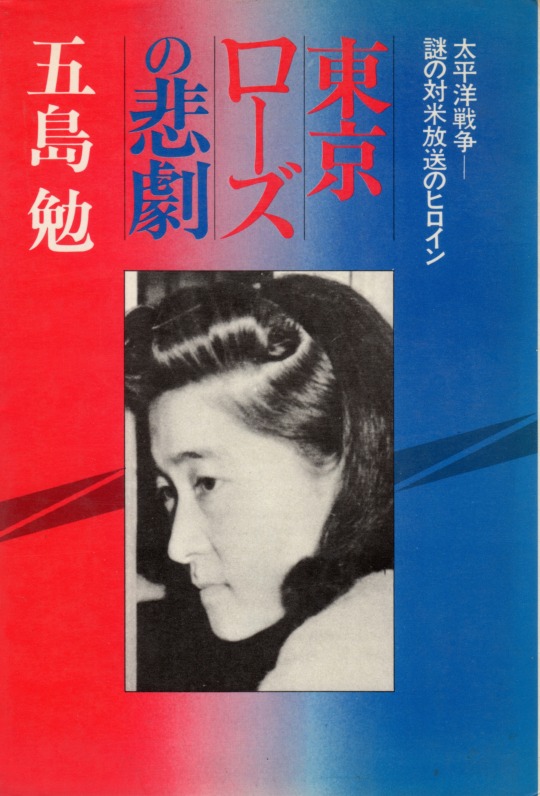
東京ローズの悲劇 五島勉 光潮社 装幀=小林孝男 「太平洋戦争-謎の対米放送のヒロイン」
6 notes
·
View notes
Text
REC (2007)
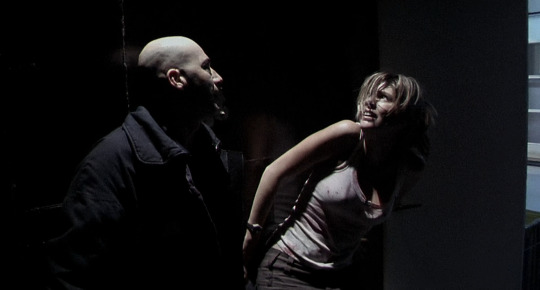
This is a Spanish foreign film, very hectic POV camera which is to be expected for the genre but it is at times very nauseating and sometimes you just want to see what is going on. All in all this is a good movie but just isn’t that unique.
⭐⭐⭐.5
Trigger warning flashing lights
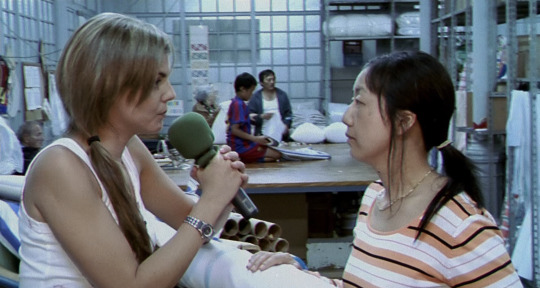
Ángela is our spunky reporter who is going to get the inside scoop on what happens during emergency calls when you work at the fire station. She is followed by her helpful cameraman, Pablo, and together they are going to make one Hell of a story. They arrive at an apartment complex after getting a call about a woman screaming alone in her apartment. Something is clearly off and the firemen go to inspect and find a very irate woman who is covered in what appears to be blood? Well if she wasn’t covered in blood before she was in a moment or so when she bites a chunk out of the face of one of the people there to help her. Woops! Anyways they hightail it out of the apartment but when they try to leave the complex they find themselves sealed in by the authorities? Whatever could be going on? Turns out there are some sick people in the building and it isn’t just a common cold they have come down with…
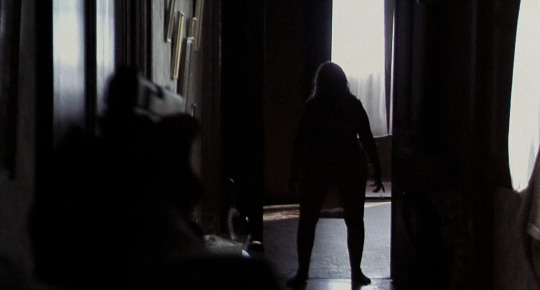
Ángela encourages Pablo to keep filming no matter what, that it is important to document all of this (whatever “this” is). After a LOT of panic a health authority figure is sent in from the outside to test the residents of the building. This is when folks start to turn into zombies really fast so don’t blink or you’ll miss it! The original guy who got bit is turning and he is biting people (woops) and it isn’t long before we are locking off another section of the complex because there are a bunch of undead sickos trying to feed on the living. We even have a little girl zombie who everyone underestimates because she is a little girl but don’t underestimate the small spunky ones! They will get you! Anyway At this point the health official has gotten bit and might I just say, don’t stand right next to a weak door with a Zomb-o on the other side if you want to survive into the next scene. I mean come ON.

Pablo continually rolling the camera makes sense for most of the film until we get to the near end where they are looking for the keys to the basement and possibly a way out. It is just very difficult to justify Pablo behind the camera then, like, come on buddy, put the camera down and help her look for the keys to escape, dog. It ends up being a good thing that he kept it around because they needed the flashlight later but still, I had to point it out. It finally gets down to just Ángela and Pablo, they make it up to the penthouse, they are more or less surrounded by the undead. The penthouse is a creepy shithole, to put it plainly. It has all these newspaper clippings about a possessed girl and lots of relics for Jesus and God but you can tell it is not a holy place.
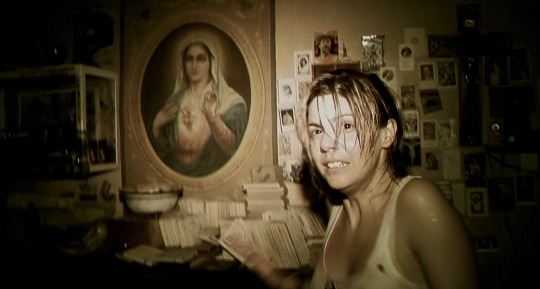
Our film ends the way it unfortunately had to, there was no way anyone was going to get out of that cage alive. The two final babes find something in the attic which knocks out the camera's flashlight (woops) so now they are in the pitchest of black save for Pablo with his night vision. Through the lens Pablo can see a horrifying creature, I suppose it is supposed to be the possessed girl but it looks like something horrible and elongated, barely human. The witch-like creature scuttles into view with a weapon in hand, either a hammer or an axe, the two try to get away but a noise gives them up. Pablo is taken first and is bludgeoned with the instrument, next Ángela is dragged away. Credits.
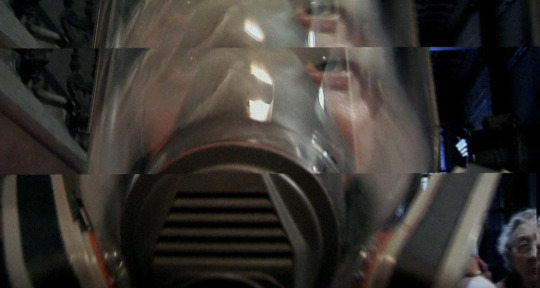
-----------------------HANNAH WATCHES HORROR--------------------
#R#Rec#REC#Rec movie#REC 2007#rec 2007 review#rec review#horror mystery#horror mystery review#horror#horror review#3.5 stars#mystery#mystery review#paco plaza#jaume balagueró#manuela velasco#pablo rosso#jorge yamam serrano#javier botet#farran terraza#david vert#martha carbonell#carlos lasarte#maria lanau#maria teresa ortega#akemi goto#manuel bronchud#ben temple#scary movie
1 note
·
View note
Text
Shop accordingly
Updated list of companies committed to DEI: Costco, Meijer, Kroger, Giant Grocery, Ben & Jerry’s, Ulta, Macy’s, Old Navy, Nordstrom’s, TJ Maxx, GoTo Foods (includes Moe’s Southwest Grill, Mcalister’s, Auntie Anne’s, Jamba, Cinnabon, and more…), Dollar Tree, Walgreens, Wegmans
60 notes
·
View notes
Text
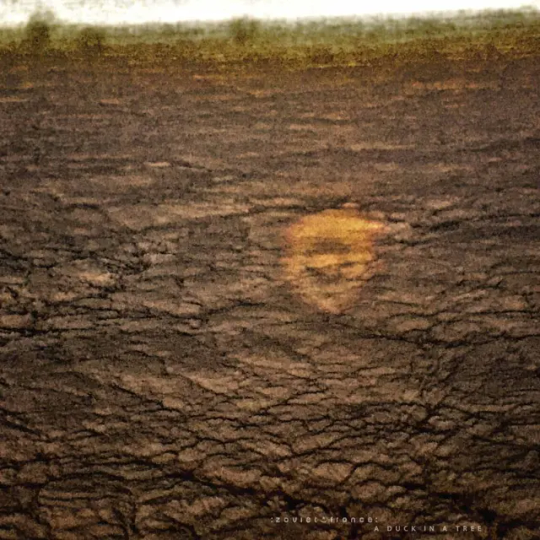
A Duck in a Tree - Borne on a Ray of Sound (2025-03-15)
zoviet*france weekly radio program listen/download
track list
00 :zoviet*france: - Intro 01 San Gabriel - SGG OD13 02 [unknown artist / unknown sound recordist] - Hypertension Within the Systemic Circulation 03 De Fabriek - Eins Minuten Spiel 04 Pimmon - goto 'bomb'; 05 Red Clouds - Red Moon in Winter 06 Deison, Cranioclast - Nico Closed Sinatra 07 Lagowski - Strange Minds 10a 08 Henna-Riikka Halonen - 100227_03 09 Ben Ponton - Waiting for the Train, Alnmouth Station, 23 January 2020 10 Sawako - Patchwork Blanket 11 [unknown sound recordist] - Closewindow ++ :zoviet*france: - Outro
#2025#zoviet france#zoviet*france weekly radio program#electronic#ambient#experimental#electroacoustic#field recording#a duck in a tree#podcast
5 notes
·
View notes
Text
10 characters / 10 fandoms / 10 tags
tagged by @fangbangerghoul, so much fun! tagging @sailor-kaiju, @atonalginger, @a-cosmic-elf, @samcoesclub
Vash the Stampede / Trigun

2. Faramir / LotR (though, specifically book faramir, but i do love david wenham)

3. Basira / The Magnus Archives (art by Feifei Wang)

4. Jester / The Mighty Nein (Critical Role, i mean, who isn't in love with laura bailey?)
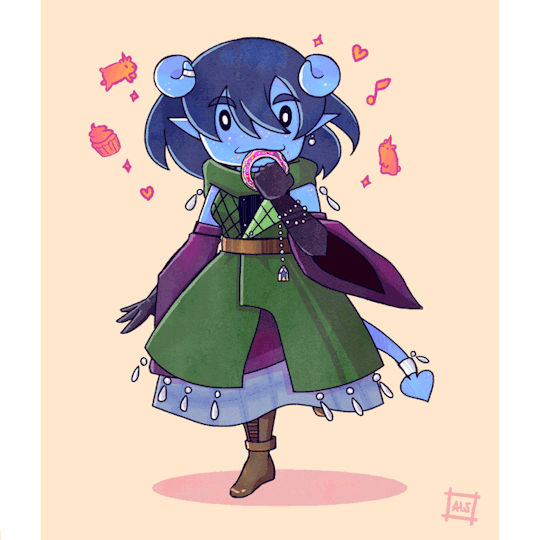
5. Susan Ivanova / Babylon 5

6. Ben Wyatt / Parks & Recreation

7. Guster Burton / Psych

8. Hiccup Haddock / How to Train Your Dragon

9. Goto Kiichi / Patlabor

10. Kusanagi Motoko / Ghost in the Shell

#trigun#lord of the rings#mighty nein#the magnus archives#babylon 5#psych#parks and rec#how to train your dragon#patlabor#ghost in the shell
11 notes
·
View notes
Text
Interpretation doesn't care about your Intent
"Something something Facts and Feelings" - Ben Shapiro
Here's the fact; interpretation doesn't care about what you mean. The facts might be "Well I said this this and this, and meant this." Or in the case of some comedians and rap artists.: "It's KFABE" or "I'm playing g a character! They shouldn't take me seriously."
Except when a core part of your audience *believes* in that character or what you're saying.
My goto example: Tyler Durden's *MASSIVE* fan base, despite him being the villain of the movie "Fight Club". The same thing with the Joker, but in the Batman, it's a little bit different, where in fight club you're supposed to take issue with Tyler Durden's childish behavior (No matter how on point his early rhetoric is) Joker , especially his more recent iterations; is a character who doesn't believe he has another choice. Or he's really just an anti-hero doing "what needs to be done" the same as Batman. (Who is in fact a criminal, doing what he believes needs to be done.)
When people believe that facade you've created, when they're rooting for the literal interpretation of what you're saying sarcastically, or maybe they interpret the wrong parts as sarcasm: it's your job as an "entertainer" or in some cases "Journalists" to ask:
What *fake-news* are you unintentionally causing?
Because the facts are; rational people believe the "fringe" and "extremist" interpretation that you Believe nobody in their right mind would.
Just like how some people see Trump as a popular-culutural referencing shit poster just having verbal *coup de tats* and others believed he was leading a literal *coup* on January 6th.
And the entire time, people were being snobs about it, "he's literally a facisist Hitler loving psychopath" there were more level-headed people saying; "No, there's people who believe what he is saying as if that facade was a real thing".
People took his "shit talking" as "fact". As if the character wasn't just a character anymore, but something more. And still more level headed people *admitted* that *that* interpretation was the one they believed more than anything.
A good politician doesn't correct his image when the results are in their favor, but God damn did the media eat it right up and completely drop the ball on that.
And that's where it falls flat with these "I love talking about my feelings for facts" groups; they don't see the massive groups of people who believe the *character* over the *facts*. After all, if they did anything about it; it might hurt their bottom line.
Who cares if the substantiation of the currency you earn goes with it.
Because when you point this out, when you get a little bit critical, they instead take a heavy handed and defensive approach. They too seem to be stuck in a "scarcity mindset" where any false move, any negative view from critical sources, could end their career in a single day.
And the question is; in this new day and age where you could several hundred thousand views for starting a Tik Tok, is that really career ending? Or are you letting the old ways of doing make you afraid of being a good journalist?
Now I get the whole "don't buy stuff from my sponsors" approach as a sort of reverse-psychological advertising, and tongue and cheek jokes..I do.
But at a certain level, at a certain level of audience trust, the question is; how much of your audience believes in the "I wanna be a gangster" shtick and how much believes that's "just an act"?
Do the facts, care, about your feelings?
So when we're being critical of each other; how much is it play-ground b.s., and how much of it isn't? I've heard that phrase a lot "it's just locker room talk" or "it's just schoolyard roughhousing" like you actually understand that's your own intent.
What about the bystanders who are telling you: "This is starting to look like a war."
5 notes
·
View notes
Text
People NEED Hobbies.
[Author's Note: ENGL 1120/COMP II Final Project, "Multimodal Argument", Final Submission.]
Okay, my title may sound fairly obvious, I know, but hear me out: I have proof! Though I could argue that every individual has experience with hobbies and their possitive effects on our lives, I won't pull that out of my hat of tricks. Instead, this proof I have is in the form of two peer-reviewed studies and a silly little book about weird hobbies. Let's get right into it.
First, in a study printed in The Journal of Experimental Education, Takayuki Goto of Osaka University studies the impact of utility-value intervention on student engagement. Students were assigned to write reflections about how the content learned in their classes is relevant and useful to their goals and daily lives outside of school. The study found that those who engaged in the utility-value intervention stayed engaged with their classes and coursework throughout the semester and turned in more assignments, while those without the intervention became less engaged and submitted less of their assignments.
Now, that is very cool and very smart. How many people go to school or a job and think: "What is this going to do for me besides a degree/money?" Besides the upkeep of daily basics needed to sustain life, what is the point of putting in so much effort? Losing sight of our goals and overall happiness can happen in these situations. Yet, knowing that external factors can give value to monotonous tasks and make them easier to complete feels enlightening. Heck, how many people started taking classes or going to a job because there was something they wanted? I, myself, do both, because there's something I want to do in life that college and a job will help me achieve. The work is hard and repetitive, but knowing that a goal, be it a future career or buying something for myself, can be obtained and maybe even bettered by my efforts makes it worth doing far more.
That's not all I found, either. I did say there were two studies.
In the Journal of Applied Research in Intellectual Disabilities, Holli M. Holmes and W. Ben Mortenson published a study on the quality of life for people with intellectual disabilities. In order to conduct this study, 19 people with intellectual disabilities were consulted. They came together in groups to discuss the things that had positive and negative impacts on their lives. The conclusion for the positives was that support, well-being, activities, and hobbies were the key factors to the improvement of quality of life.
[ https://onlinelibrary.wiley.com/doi/epdf/10.1111/jar.13280 ]
Once again, I find this study fascinating as well. Of all the things that can help improve people's lives, having something to do counts for half of the overall conclusion. If this study were to be expanded to more than 19 people, I believe that this ratio would hardly change, even if those without intellectual disabilities were to be included in the study or studied separately. How many people can honestly say that they are okay with doing nothing? This doesn't mean sitting and looking at social media or reading or watching a movie, because, in all of those instances, you are still doing an activity. This is more about when you are surrounded by activity happening and you cannot engage with it despite wanting to. To do nothing goes against being alive, and being held back from doing something, anything, makes being alive quite hard.
Well, that brings me to my very last point: a silly little book about weird hobbies.
Michael Canfeild brings together a list of diverse and seemingly strange hobbies in his book America’s Oddest Hobbies. From dog grooming to bug fighting and from mooing to eggshell carving, there is a wide range of examples of what hobbies can entail.
As much as some of these examples might seem odd and not up your alley, that doesn't mean there isn't something out there just for you. Something that might seem weird to others, too. There are a lot of non-traditional hobbies, as well as hobbies that don't seem like hobbies. Some hobbies can also consume more or less time and/or money as well. Maintaining a social media account or ranking streaks in video games count as hobbies. Collecting items found on the ground such as rocks or lost trinkets can work, too, as something you do passively as you walk down a road or hallway. Taking pieces of plants and gluing them together on a canvas into a nature collage reminisce of a 3D painting. Dressing in different colors for specific days of the week or always wearing something themed for obscure holidays. Honestly, the list could go all. Big or small, profitable or not, hobbies like these can make living life better. Who knows, maybe if you are interested in profit and put yourself into doing well, others could see your work, take interest, and be open to the idea of buying what you do.
So, given what I've said thus far, my point stands strong. People need hobbies, and my proof sits in two studies and a silly little book. Improve your school and work life, improve your life over all, and go get yourself your own hobby. I know I have. Mine? I like to intentionally and perfectly tie a game of checkers without anyone losing any pieces. :D
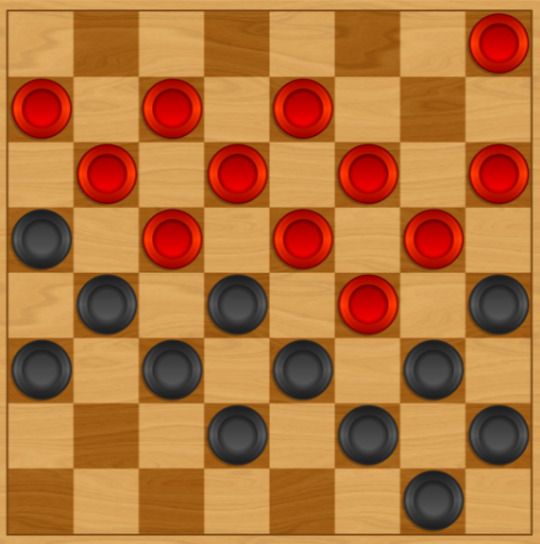
0 notes
Video
vimeo
Porter Robinson - Cheerleader from Hugh Mulhern on Vimeo.
PRODUCTION Production Company: Riff Raff Director: Hugh Mulhern EP/Producer: Precious Mahaga EP: Natalie Arnett Director's Representation: Hands Executive Producer: Porter Robinson Executive Producer: Slush Management (Aaron Greene, Neal O'Connor, Amar Pathak, Samuel Luria, Valerie Maybaum, Ryan Glatt) Creative Director: Pablo Jones Soler
BTS/DIGITAL Paul Mauer
SERVICE COMPANY Solent Film MD: Alex Momchev Solent Film MP: Magdalena Staneva Solent Film Service Producer: Tihomira Temelkova Assistant Producer: Elena Doroshenko Production Manager: Mitko Milushev Production Coordinator: Teodora Naydenova Production Assistants: Eva Taneva, Simona Atanasova, Serafima Deyanova, Dimitar Borisov
CASTING DIRECTOR Veselina Georgieva
AD'S 1st AD: Antony Tanev 2nd AD: Margarita Aneva 3rd AD: Damyan Tanev
CAMERA DOP: Nikita Popkov 1st AC: Vladislav Mateev 2nd AC A camera: Ivaylo Yovchev 2nd AC B camera: Luciano Ivanov Video Control: Borislav Stoyanov Drone Operator: Nikolay Georgiev - Tanera Data Manager: Delyan Kaloyanov
LIGHTING Gaffer: Alexander Trenev Electricians: Vasil Vasilev, Georgi Tsanev, Dimitar Yanev, Boris Vasilev Dimmer Board Operator: Philip Georgiev
GRIP Key Grip: Tsvetan Kostov Grips: Albert Nikolinski, Dimitar Dimitrov, Yulian Gotchev, Mihail Gotsov, Emil Ivelinov Head Technician: Borislav Tanev Crane Technician: Stanimir Vatsov
SOUND Playback: Kostadin Separevski
ART Production Designer: Elena Isolini Production Designer Assistant: Theresa Bates Art Directors: Momchil Tasev, Aleksandar Yanev Construction Manager: Minko Krustev Props Master: Ada Paunova On-Set Dressers: Nedelcho Hazarbasanov, Yavor Milanov Set Dressers: Kostadin Dervenski, Evtim Evtimov
LOCATION Location Manager: Anita Miletieva Assistants: Elena Karadusheva, Lidiya Aleksandrova
STUNTS Stunt Coordinator: Ivan Vodenicharov Stunt Dept. Coordinator: Aneta Ivanova Stunts: Marina Yordanova, Desislava Slavova, Tea Markova, Mariela Kostadinova, Ventsislav Hristov
CHOREOGRAPHY Kosta Karakashyan
SFX Supervisor: Nikolay Fartunkov Senior Technician: Ivan Kazakov Technicians: Vladimir Mitov, Blagoslav Zhenkov
HAIR/MAKE-UP Hair Cut & Color: Miyuki Goto Artist's Hair & Make-up Artist: Yesol Choi Artist's Hair & Make-up Artist Assistant: Gohun Kim Head of Make Up: Gergana Batanova Head of Hair: Veselka Tsekina Hair Stylists: Bilyana Borisova, Gergana Ivanova, Nataliya Kamenova, Gratziela Dimitrova
COSTUME Artist's Stylist: Luca Wowczyna Luca's Assistant: Elliott Lane Assistant Stylists: Maria Petrova, Teodora Marinova, Nadya Dobrikova, Yoana Kusheva, Emiliyan Bonev Tailor: Marieta Duncheva Mask Design: Audrey Mai
ORGANIZATION Set Manager: Georgi Asenov PAs: Lyubomir Tabakov, Ivaylo Tabakov, Vulcho Monkov
STOP MOTION: THE JUNKS Stop Motion Supervisor: Zlatin Radev Animator: Boris Wolf Assistant Animator / Puppet Doctor: Diliana Valcheva Rigger / Assistant Animator: Teodor Ralev Set Dressers: Alex Suninski, Marin Nalbantov
EDITING: TRIM EDITING Editor: Joseph Taylor Edit Assistant: Anders Mills Producer: Noreen Khan
POST PRODUCTION VFX Supervisor: Vasil Galabov VFX: The Mill EP: Saskia Delius Producer: Sam Ashby 2D Lead: Ben Gallagher 2D Assists: Henry Claud N’guetta, Jane Williams, Muhaddissa Hasham Associate Producer: Rushikesh Shelar Production Coordinator: Karishma Verma Compositor Supervisor: Nanda P V Compositor Lead: Ragesh Ramachandran Rotoscoping Supervisor: Kunal Bendke Prep Lead: Jalander Madishetty GABHA Studios: Dafydd Upsdell, Daniel Morris Grade: Andrew Francis Add’l Post Production: Andrzej, Nina Muro, Nick Lane CGI: Alex (chippy) Futtersak, Dom Harwood VFX Artists: David Ochoa
TRANSPORT Coordinator: Vladimir Mashinata Blagoev Prod Vans: Svetoslav Yordanov, Ivo Radkov, Iliya Iliev, Georgi Evstatiev
CATERING Cherry Craft & Catering Manager: Mariela Manolova Cherry Craft & Catering: Petya Kovacheva, Ivan Nalbatski, Borislav Parvanov
SUNWEAVER CREATIVE Shawn Chapman: Producer - Creative Jacqueline Adorni: Producer Garrett Robles: 3D / Previs Lauren Sperling: Project Coordinator Matthew Hunt: Production Assistant
WARDROBE / COSTUME: VENIA Christine Ko: Key Costumer Keeter Ly: Key Costumer
WARDROBE / COSTUME: SUNWEAVER Cybal Hall: Costume Supervisor Annabelle Gerke: Key Costumer Christopher Hall: Costumer (Silkscreening) Daniel Rose: Lead Wig Designer Kieran Smith: Wig Stylist Samantha Michael: Wig Stylist
ART DEPARTMENT Kigarumi Sensei Taiki Nishikawa: Key Artist Paul Nishikawa: Artist
Creative Character Engineering Andrew Clement: Lead Artist Lesley Becerra: Head of Production Brad Palmer: Sr. Project Manager Cory Fisher: 3D print/fabrication Alex Dill: Fabrication Mike Ross: Fabrication
Special Thanks - Venia
1 note
·
View note
Text
277 - iPhone 15 Pro Max Camera at U2 - With Kelly Guimont, Jeff Gamet, and Ben Roethig
The latest In Touch With iOS with Dave he is joined by guest Kelly Guimonr, Jeff Gamet, and Ben Roethig. Dave was able to goto the U2 concert at the Sphere Las Vegas and gives his review of the amazing tech at the show and how the iPhone 15 Pro Max camera photo quality is. Report says that those using CarPlay tend to listen to AM/FM radio instead. Many updates to iOS including older versions with the latest 17.1 now out. Apple is raising prices on 3 services including Apple TV+ News+ alongwith the Apple One bundle. Kelly brings us a great Qi charging stand as well Jeff does the unboxing. Plus much more.
The show notes are at InTouchwithiOS.com
Direct Link to Audio
Links to our Show
Give us a review on Apple Podcasts! CLICK HERE we would really appreciate it!
Click this link Buy me a Coffee to support the show we would really appreciate it. intouchwithios.com/coffee
Another way to support the show is to become a Patreon member patreon.com/intouchwithios
Website: In Touch With iOS
YouTube Channel
In Touch with iOS Magazine on Flipboard
Facebook Page
Mastadon
Twitter
Instagram
Spoutible
News
Apple Announces October Event for Macs: 'Scary Fast' and add Ben he wrote and article on this. https://roethigtech.blogspot.com/2023/10/apple-announced-its-scary-fast-event.html
Apple Pay Later Officially Launches in U.S. Following Early Access Period
Apple Stores Begin Same-Unit iPhone 15 Repairs as Parts Now Available
Topics
Older iOS version updates.
Apple releases iOS 16.7.2 and iOS 15.8 security updates to patch old hardware
About the security content of iOS 15.8 and iPadOS 15.8
About the security content of iOS 16.7.2 and iPadOS 16.7.2
Beta this week.iOS 17.2 Beta 1 was released.
Apple Seeds First Betas of iOS 17.2 and iPadOS 17.2 to Developers
Everything New in iOS 17.2 Beta 1: Journal App, Translate Action, iMessage Sticker Reactions and More
iOS 17.2 Beta Introduces Journal App
iMessage Contact Key Verification Added in iOS 17.2 and macOS Sonoma 14.2
iOS 17.2 Beta Adds Translate Option for Action Button
Apple Seeds First Beta of watchOS 10.2 to Developers
Apple Seeds First Beta of tvOS 17.2 to Developers
iOS 17.1 was released to all.
iOS 17.1 Features: What's New in iOS 17.1
About the security content of iOS 17.1 and iPadOS 17.1
Apple Releases iOS 17.1 and iPadOS 17.1 With AirDrop Over Internet, Music Favorites Options and More
Apple Brings Enhance Dialogue to Original HomePod and HomePod mini With 17.1 Update
Apple Releases tvOS 17.1
watchOS 10.1 Fixes Apple Watch Weather Complication Bug
Everything You Can Do With the Double Tap Gesture on Apple Watch
Apple is raising the prices on all its services. Apple TV+, Arcade, and News+ subscription price increases from today are you going to still pay the increased price? Upset With Apple's Price Increases? Here's How to Cancel Your Apple TV+ or Apple One Subscription
Apple TV+: $6.99 per month → $9.99 per month
Apple Arcade: $4.99 per month → $6.99 per month
Apple News+: $9.99 per month → $12.99 per month
Prices for the Apple One bundles that include these services are also increasing as a result:
Individual: $16.95 per month → $19.95 per month
Family: $22.95 per month → $25.95 per month
Premier: $32.95 per month → $37.95 per month
CarPlay is a great way to listen and navigate. With all the media thats available out there People with CarPlay are mostly just listening to AM/FM radio We discuss this further.
Dave attended the U2 concert at the Sphere Las Vegas. He used his iPhone 15 Pro Max and reviews the show and experience using the camera.
Link to photo examples: https://flic.kr/s/aHBqjB19Ye
Kelly has an amazing item pick https://amzn.to/3tGPN2Y
MURCIA 2 in 1 Magnetic Wireless Charger, Folding Dual Fast Magnetic Wireless Charging Station Stand
Announcements
Macstock 7 2023 Digital Pass is now available. Relive the conference as you can Purchase a virtual pass to see the talks that many of our regular guests and contributors did including Dave, Brittany, Chuck, and Jeff. https://macstockconferenceandexpo.com
Our Host
Dave Ginsburg is an IT professional supporting Mac, iOS and Windows users and shares his wealth of knowledge of iPhone, iPad, Apple Watch, Apple TV and related technologies. Visit the YouTube channel https://youtube.com/intouchwithios follow him on Mastadon @daveg65,
Twitter @daveg65.and the show @intouchwithios
Our Regular Contributors
Jeff Gamet is a podcaster, technology blogger, artist, and author. Previously, he was The Mac Observer’s managing editor, and Smile’s TextExpander Evangelist. You can find him on Mastadon @jgamet as well as Twitter and Instagram as @jgamet His YouTube channel https://youtube.com/jgamet
Ben Roethig Former Associate Editor of GeekBeat.TV and host of the Tech Hangout and Deconstruct with Patrice Mac user since the mid 90s. Tech support specialist. Twitter @benroethig Website: https://roethigtech.blogspot.com
About our Guest
Kelly Guimont is a podcaster and friend of the Rebel Alliance. She appears on The Incomparable network as well as hosts I Want My M(CU) TV. you can find her on Mastodon and Instagram @verso
Here is our latest Episode!
0 notes
Text
La gente recurre a lo oculto cuando las cosas se ponen difíciles.
La gente recurre a lo oculto cuando las cosas se ponen difíciles.
Después de la tercera Guerra del Medio Oriente en 1973, cuando los suministros de energía de Japón se vieron amenazados por el embargo de petróleo de los proveedores de la OPEP, un autor llamado Ben Goto (1929-2020) alcanzó la fama de la noche a la mañana con su publicación de 1973 de las “Grandes profecías de Nostradamus”. Ese libro vendió 2,5 millones de copias, y con varias secuelas que…

View On WordPress
1 note
·
View note
Photo

世界の廃墟物語-失われた栄華の跡を求めて 五島勉 光文社文庫 カバー・本文イラスト=レオ・澤鬼
27 notes
·
View notes
Photo

Omniverse Mass Effect Pt. 2
#Commander Shepard#femshep#Jacob Taylor#kasumi goto#legion#Miranda Lawson#grunt#jack#Zaeed Massani#mordin solus#justicar samara#thane krios#mass effect#ben 10 omniverse#fanart#q
336 notes
·
View notes
Text
Ryoga: New Beginning Lyrics
Kanji, romaji and English translation for New Beginning by Ryoga
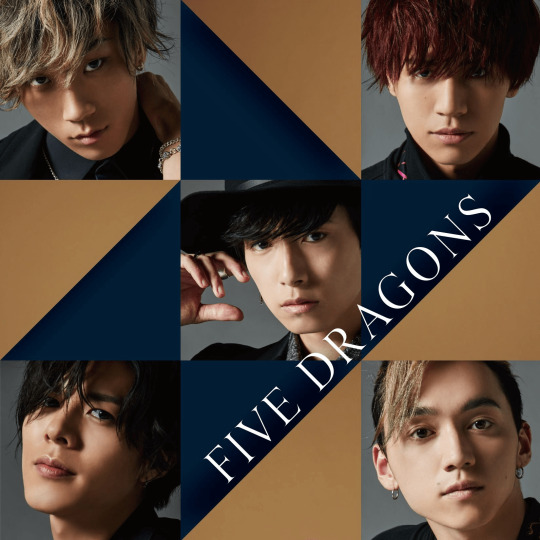
(kanji source)
歩いて来た旅路 続いていくよ未来 その真ん中に
両足で立ち 風向き 星空 耳澄ました
君の価値 分かる人の価値 何処よりも高い 旅の先 人差し指についた傷と痛み それでも翳し続け 得る 光
i tell you in your heart いつでも 君ならやれるさ
thanks for everything 今 行こう brand new day 背中に託すのは勇気さ thanks for everything ほら 誘う brand new sun you keep on going going go you keep on going going go
new beginning new beginning new beginning new beginning
築いてきた形 裸の自分の位置 絡まる気持ち ゼロに戻して リセットボタンを押してみるよ
君を抱きしめたその人は聞いた 「やるか?」「やるさ」君は応えた 重ねて重ねた 花の可能性 瓦礫に咲いて 「h-llo「yeah~」」
i tell you in your heart いつでも 君を信じてるよ
thanks for everything 今 行こう brand new day 背中に光るのは笑顔さ thanks for everything ほら 誘う brand new sun you keep on going going go you keep on going going go
わかってるよどこにいても 地球の上さ 心に突き立てた flag 大きく掲げるよ
thanks for everything 今 行こう brand new day 背中に託すのは掌 thanks for everything ほら 誘う brand new sun you keep on going going go you keep on going going go
new beginning new beginning new beginning new beginning
Romaji
aruitekita tabiji tsuzuiteikuyo mirai sono mannaka ni
ryouashi de tachi kazemuki hoshizora mimi sumashita
kimi no kachi wakaru hito no kachi doko yori mo takai tabi no saki hitosashiyubi ni tsuita kizu to itami soredemo kazashi tsuzuke eru hikari
i tell you in your heart itsudemo kimi nara yareru sa
thanks for everything ima ikou brand new day senaka ni takusu no wa yuuki sa thanks for everything hora sasou brand new sun you keep on going going go you keep on going going go
new beginning new beginning new beginning new beginning
kizuitekita katachi hadaka no jibun no ichi karamaru kimochi zero ni modoshite risetto botan wo oshite miruyo
kimi wo dakishimeta sono hito wa kiita "yaruka?" "yaru sa" kimi wa kotaeta kasanete kasaneta hana no kanousei gareki ni saite "h-ello 'yeah~'"
i tell you in your heart itsudemo kimi wo shinteruyo
thanks for everything ima ikou brand new day senaka ni hikaru no wa egao sa thanks for everything hora sasou brand new sun you keep on going going go you keep on going going go
wakatteruyo doko ni itemo chikyuu no ue sa kokoro ni tsukitateta flag ookiku kakageruyo
thanks for everything ima ikou brand new day senaka ni takusu no wa tenohira thanks for everything hora sasou brand new sun you keep on going going go you keep on going going go
new beginning new beginning new beginning new beginning
English
I've walked this journey The future will go on In that middle
I stood on both legs And listened carefully to the wind direction and the starry sky
The value of people who know your value Ahead of a journey higher than anywhere else My index finger is covered in wounds and pain But even so, I continue to hold it up and obtain light
i tell you in your heart always I know you can do it
thanks for everything Now Let's go brand new day What's on your back is courage thanks for everything Look An inviting brand new sun you keep on going going go you keep on going going go
new beginning new beginning new beginning new beginning
I've built a shape The place of my naked self I try to turn back to zero My entwined feelings And press the reset button
That person who embraced you asked "Will you do it?" "I'll do it" You answered The possibilities of piled up flowers Bloom on rubble "h-llo 'yeah~'"
i tell you in your heart always I believe in you
thanks for everything Now Let's go brand new day What's shines on your back is a smile thanks for everything Look An inviting brand new sun you keep on going going go you keep on going going go
Wherever I am, I know I'm on top of the Earth I'll greatly hoist the flag That was pierced in my heart
thanks for everything Now Let's go brand new day What's on your back is a hand thanks for everything Look An inviting brand new sun you keep on going going go you keep on going going go
new beginning new beginning new beginning new beginning
#ryoga#five dragons#new benning#Mitani Reo#kishimoto yuta#ide takuya#goto keitarou#shimizu keita#request
2 notes
·
View notes
Text
Second Season Announced For B: The Beginning Anime
Netflix recently announced at the Annecy International Festival of Animated Film that a second season of the B: The Beginning anime series will be available in the near future.
For those who are unaware, the series is a Netflix original series, which premiered on the service worldwide on March 2 with the first season consisting of 12 episodes.
Netflix provided a description for the series.
In a…
View On WordPress
#Abbot#Allegra Clark#Ami Koshimizu#and Kōji Fujimoto. Ray Chase#Anime#Anime News#Asami Seto#Atsushi Goto#Ben Diskin#Blue#Boris#Brandon#Brianna Knickerbocker#Cristina Vee#Darkon633#Derek Stephen Prince#Doug Stone#Dr. Flick#Edward Bosco#Eric#Erica Mendez#Erika#Ezra Weisz#Faye Mata#Henry#Hero Club#Hiroaki Hirata#Hiroki Touchi#Izanami#Jake Eberle
3 notes
·
View notes
Text

Nerdy AU
Looking For Raid by @p0lkadotdotdot: Kyl0R3n is a Cyborg tank. Lightbeam is a Monk healer. Almost every night they chat together, raid together and occasionally hit the battlegrounds of the internationally popularMMO Star Republic. Ben Solo is an architect. Rey Jackson is a structural engineer. Both work together at New Order Construction and can be seen frequently at each others throats.If only they knew... "Anyone could be anyone behind a screen and keyboard..."
Play To Win by Enterprisingly: Ben Solo – aka KyloRen – is a professional gamer, playing the first-person-shooter StarKiller for the internationally ranked eSports team, The First Order. He’s made a name for himself as a ruthless competitor with a ferocious temper and top-notch skills that can’tbe beat. That is, until a mystery player named ReyOfLight begins thoroughly trouncing him whenever they cross paths.What follows is the unlikely story of a rivalry that turns into a friendship that turns into … something else entirely, all while the eSports community watches with bated breath and popcorn in hand.
enemies-to-lovers by @the-reylo-void: Six months ago, the popular space opera Lost Galaxy did the unthinkable: it made the controversial enemy-soldier ship MattKira canon. That would be bad enough on its own, but then anti blogger Rey finds a MattKira fanfiction reblogged onto her dashboard. Her solution? Start hate-reading it and posting a running commentary on just how bad it is. One problem. The fic is actually pretty good. And then the author, KyloRen, sends her a message...
Talk to You Later by @soloredeemed: Ben and Rey are both on tumblr, they like the same fandom, and one of them stumbles upon and likes the other's post. Ben (KyloRen) is pretty well known in the Space Wars fandom, and Rey (JustRey) never expected him to reply when she sent him a dm. The two slowly become friends... (and then some). But KyloRen is, well, not who he says he is.
And I wish that you were here by @meadowhayle: Just when Rey is about to see her online boyfriend Kylo for the first time, her car breaks down in the middle of a snowed in forest. Forced to look for help she ends up at Ben Solo's cabin, who seems to be more than meets the eye.
if you're ready comic get it by violethoure666: When a chain store opens across the street from Rey's comic book store, she decides to goto war with the loathsome new owner, little realizing he's the same guy she's been internet crushing on forever. Modern You've Got Mail AU with way more comic books and tumblr instead of email.
Inked by @kylosspaceprincess: Rey Jackson is a comic book artist who works for Kyber Publishing. She spends her time sketching out comics in pencil and then sending them off to someone who will color and ink them. Kylo Ren is that someone. The two have never met, although they simply despise each other. Rey hates how Kylo sometimes colors the drawings opposite to how she imagines them, and Kylo hates how messy her sketches are and how he has to decipher which lines are meant to be there.
Skywalker Comics by msmerlin: When Rey shows up to work one rainy night during monsoon season she never expected tofind out Luke sold Skywalker Comics and that her new boss was more than she bargainedfor.
41 notes
·
View notes
Text
i goto ben i bush my teef n got on pajamas & hab water & my medesin all redy 4 bed goonite! :D
7 notes
·
View notes